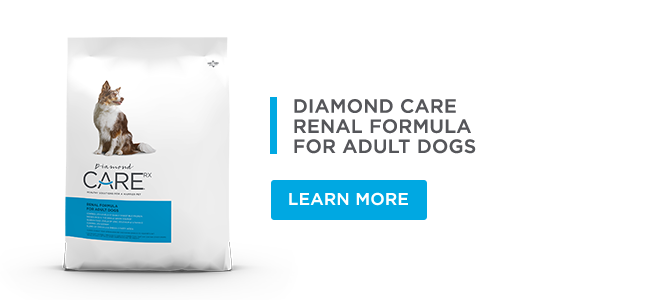There may be no cure for kidney disease, but there are ways to slow disease progression, help your dog feel better and even extend his or her life. Choosing the right renal diet is one of the most powerful ways to accomplish that.
In one study, dogs with chronic kidney failure fed a renal diet lived an average of 13 months longer than dogs fed a maintenance diet.1 Those on the renal diet were also less likely to show clinical signs such as nausea, loss of appetite and lethargy, compared to dogs on the maintenance diet.1
Most renal diets differ from maintenance diets in that they have slightly lower levels of protein and sodium and moderately increased amounts of omega-3 fatty acids. They may also have guaranteed levels of antioxidants for immune support. But reduced phosphorus in dog food is one of the most important features of an effective renal diet.
Phosphorus and the kidneys
The kidneys are responsible for filtering waste products from the blood. As kidney function becomes compromised, blood levels of waste products such as the mineral phosphorus, become elevated, resulting in a condition called hyperphosphatemia.
Too much phosphorus in the blood interferes with calcium metabolism and contributes to further progression of chronic kidney disease.
Reducing dietary phosphorus
They way to successfully manage phosphorus levels in kidney disease will vary by the individual dog. It’s best to work with your veterinarian, who can evaluate your dog’s blood phosphorus levels and clinical signs, and tailor recommendations to your dog’s specific condition.
Often, the first step to help normalize phosphorus levels and slow the progression of kidney disease is to feed a diet that contains phosphorus levels that are lower than typical maintenance diets. Since protein contains phosphorus as well, the slightly lower protein levels in renal diets also help reduce the phosphorus content.
What kind of difference can dietary phosphorus restriction make? In a study of 24 dogs with kidney failure, half were fed a diet with phosphorus restriction while the other half were fed a diet with regular phosphorus levels for two years.2 Dogs in the low phosphorus group had a higher survival rate (75%) than those in the high-phosphorus group (33%).2
Next step: Phosphorus binders
In the early stages of kidney failure, feeding a diet with reduced phosphorus may be all it takes to normalize phosphorus blood levels. But as kidney failure progresses, your veterinarian may recommend additional treatments, such as phosphorus binders.
These medications work by binding with phosphorus in the digestive tract to reduce the amount of dietary phosphorus that is absorbed into the body.
As always, work with your veterinarian to find the right renal treatment for your dog. Dietary management, with a food made with carefully regulated levels of phosphorus, such as Diamond CARE Rx Renal Formula for Adult Dogs, is a natural first step to help improve your dog’s quality of life.
References
- Jacob F, Polzin DJ, Osborne CA, et al. Clinical evaluation of dietary modification for treatment of spontaneous chronic renal failure in dogs. J Amer Vet Med Assoc 2002;220(8):1163-1170.
- Finco DR, Brown SA, Crowell WA, et al. Effects of phosphorus/calcium restricted and phosphorus/calcium-replete 32% protein diets in dogs with chronic renal failure. Am J Vet Res 1992;53(1):157-163.








